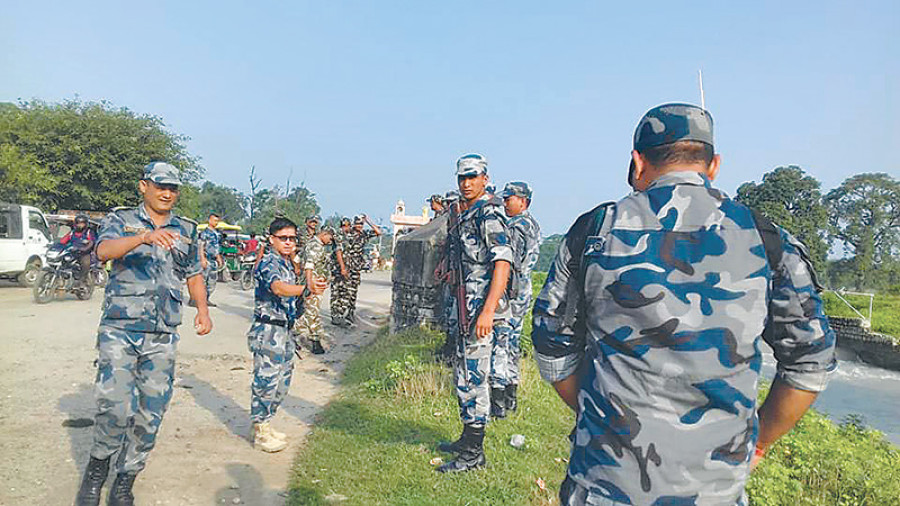Miscellaneous
Nepal and India border group meet starts today
Survey officials from Nepal and India plan to approve 2022 as the new timeline to complete bilateral boundary work during the fifth meeting of Nepal-India Boundary Working Group starting in Kathmandu on Wednesday.
Anil Giri
Survey officials from Nepal and India plan to approve 2022 as the new timeline to complete bilateral boundary work during the fifth meeting of Nepal-India Boundary Working Group starting in Kathmandu on Wednesday.
The three-day meeting is likely to decide that by 2022 all boundary work in the field should be complete.
Department of Survey Director General and leader of Nepali panel at the BWG Ganesh Bhatta said, “This meeting will approve the new timeline of 2022 to complete all boundary work, despite the issue of Susta and Kalapani border. We will also review the progress made during the last four years and will decide to speed up the task to meet the deadline.”
The Department of Survey data shows Nepal and India have installed 8,554 pillars along the border. Of these, 1,325 are missing and 1,956 are damaged or in partially damaged state.
The issue of resolving the Susta and Kalapani border dispute was given to the foreign secretaries of both countries in 2014. They did not meet even once in four years to resolve the issue.
In December 2015, Survey Officials’ Committee meeting, held in Dehradun the capital of Indian state Uttarakhand, had agreed to complete the remaining work within four years—by 2019.
The parties pushed the deadline to 2022 because of paltry progress on the field due to various reasons including limited funds.
The BWG, Survey Officials’ Committee (SOC) and Joint Field Survey Teams (FSTs) made little progress in four years.
All three teams had the task of constructing, restoring and repairing boundary pillars, clearing the no-man’s land, GPS mapping of boundary pillars, collecting data of property holdings across the border and resolving any other boundary dispute.
Some progress on identifying and maintaining boundary pillars, and clearing the No-man’s land has been made, the official said.
Both sides have deployed four separate teams in four different sections to settle the row over boundary pillars. The FSTs have completed their tasks in four of the 27 districts.
“We could not start work in the first year. In the second year, we started installation of new border pillars and maintenance of those damaged. Out of the 8,554 border pillars, we have repaired or installed over 6,000 boundary pillars,” said Bhatta.
Nepal and India share 1,880 km long border spanning over 27 districts. Currently, boundary work in Jhapa, Sunsari, Kailali and Parsa districts is complete.
The BWG meeting has to prepare a blueprint to complete the remaining boundary work, data of properties held by citizens on either side of the border, installing and repairing 8,554 boundary pillars, installing GPS facilities and resolving the boundary dispute where river changed the course.
“Most of the property holdings problems on both the sides are due to the changes in rivers’ course. The major issue is collecting the complete data of citizens’ property holdings on both sides of the border. We aim to complete it before 2022. Both governments would decide after we submit our reports to them,” Bhatta said.
Due to the changes in the course of hundreds of rivers, thousands of hectares of land have slipped either side of the border whose data is collected by the SOC and FSTs.
During its meeting in India last year, the BWG had decided to deploy four separate teams to inspection the border.
The first to keep record of pillars; the second to reconstruct missing or damaged pillars; the third to clear the no-man’s land; handle property holding issues and conduct inventory; and the fourth to study GPS and co-ordinate the border pillars and boundary along with the maps prepared by the both sides.
The construction, restoration and repairs of boundary pillars would be done via GPS with the reference of 182 sheets of maps prepared by both sides.
Both parties agreed to form the Nepal-India Boundary Working Group (BWG) during Indian External Affairs Minister Sushma Swaraj’s visit in July 2014.




 13.12°C Kathmandu
13.12°C Kathmandu










